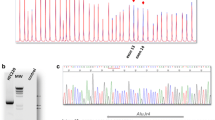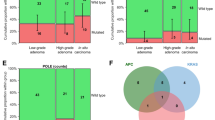Abstract
The right colon differs from the left, in embryological origin, luminal environment, and function. In both sporadic colorectal cancer and Familial Adenomatous Polyposis (FAP), polyp density and cancer susceptibility vary markedly by colonic site. Adenomas in FAP have a different mutational spectrum in small intestine versus colon. This study aimed to investigate whether colonic location also influences the APC mutation spectrum in FAP. 127 1–2 mm mildly dysplastic adenomas from 5 patients with a codon 1309 germline mutation, and 41 from 3 patients with mutations proximal to codon 1265, were analysed to assess the frequency of loss of heterozygosity (LOH). We chose polyps from different locations in the colon. Immunohistochemistry for beta-catenin, caspase-3 and Ki-67 was performed to assess Wnt pathway activation, apoptosis and proliferation. In polyps from patients with a 1309 mutation, the frequency of LOH showed a gradient from rectum (highest) to caecum/ascending colon (lowest), but this was not present in patients with proximal germline APC mutations. Crypt-by-crypt analysis confirmed the LOH findings from whole polyps. Beta-catenin and caspase-3 expression showed no significant variation by colonic region, but Ki-67 expression decreased from ascending colon to rectum in tumours and normal tissue. Colonic site alters the mutational spectrum of APC, and crypt cell proliferation. The higher frequency of LOH in rectal polyps from patients with codon 1309 mutations may help to explain their increased polyp burden at this site compared with patients who have other germline APC mutations.

Similar content being viewed by others
Abbreviations
- FAP:
-
Familial adenomatous polyposis
- APC:
-
Adenomatous polyposis coli
- LOH:
-
Loss of heterozygosity
References
Ficari F, Cama A, Valanzano R et al (2000) APC gene mutations and colorectal adenomatosis in familial adenomatous polyposis. Br J Cancer 82(2):348–353
Keating J, Pater P, Lolohea S, Wickremesekera K (2003) The epidemiology of colorectal cancer: what can we learn from the New Zealand Cancer Registry? N Z Med J 116(1174):U437
van Gorkom BA, Cats A, van der Meer R et al (1997) Effects of hemicolectomy on bile acid metabolism in relation to colon carcinogenesis in man. Eur J Clin Invest 27(7):589–594
Oh SW, Kim YH, Choi YS et al (2008) The comparison of the risk factors and clinical manifestations of proximal and distal colorectal cancer. Dis Colon Rectum 51(1):56–61
Nusko G, Mansmann U, Altendorf-Hofmann A, Groitl H, Wittekind C, Hahn EG (1997) Risk of invasive carcinoma in colorectal adenomas assessed by size and site. Int J Colorectal Dis 12(5):267–271
Park YJ, Park KJ, Park JG, Lee KU, Choe KJ, Kim JP (1999) Prognostic factors in 2230 Korean colorectal cancer patients: analysis of consecutively operated cases. World J Surg 23(7):721–726
Sjo OH, Lunde OC, Nygaard K, Sandvik L, Nesbakken A (2008) Tumour location is a prognostic factor for survival in colonic cancer patients. Colorectal Dis 10(1):33–40
Anti M, Armuzzi A, Morini S et al (2001) Severe imbalance of cell proliferation and apoptosis in the left colon and in the rectosigmoid tract in subjects with a history of large adenomas. Gut 48(2):238–246
Liu LU, Holt PR, Krivosheyev V, Moss SF (1999) Human right and left colon differ in epithelial cell apoptosis and in expression of Bak, a pro-apoptotic Bcl-2 homologue. Gut 45(1):45–50
Kushiyama Y, Fukuda R, Suetsugu H et al (2000) Site-dependent production of transforming growth factor beta1 in colonic mucosa: its possible role in tumorigenesis of the colon. J Lab Clin Med 136(3):201–208
Mills S, Mathers J, Chapman PD, Burn J, Gunn A (2001) Colonic crypt cell proliferation state assessed by whole crypt microdissection in sporadic neoplasia and familial adenomatous polyposis. Gut 48(1):41–46
Baker K, Zhang Y, Jin C, Jass JR (2004) Proximal versus distal hyperplastic polyps of the colorectum: different lesions or a biological spectrum? J Clin Pathol 57(10):1089–1093
Deng G, Kakar S, Tanaka H et al (2008) Proximal and distal colorectal cancers show distinct gene-specific methylation profiles and clinical and molecular characteristics. Eur J Cancer 44(9):1290–1301
Lüchtenborg M, Weijenberg MP, Roemen GM et al (2004) APC mutations in sporadic colorectal carcinomas from The Netherlands Cohort Study. Carcinogenesis 25(7):1219–1226
Albuquerque C, Breukel C, van der Luijt R et al (2002) The ‘just-right’ signaling model: APC somatic mutations are selected based on a specific level of activation of the beta-catenin signaling cascade. Hum Mol Genet 11(13):1549–1560
Crabtree M, Sieber OM, Lipton L et al (2003) Refining the relation between ‘first hits’ and ‘second hits’ at the APC locus: the ‘loose fit’ model and evidence for differences in somatic mutation spectra among patients. Oncogene 22(27):4257–4265
Lamlum H, Ilyas M, Rowan A et al (1999) The type of somatic mutation at APC in familial adenomatous polyposis is determined by the site of the germline mutation: a new facet to Knudson’s ‘two-hit’ hypothesis. Nat Med 5(9):1071–1075
Groves C, Lamlum H, Crabtree M et al (2002) Mutation cluster region, association between germline and somatic mutations and genotype-phenotype correlation in upper gastrointestinal familial adenomatous polyposis. Am J Pathol 160(6):2055–2061
Will OC, Robinson J, Gunther T, Phillips RK, Clark SK, Tomlinson I (2008) APC mutation spectrum in ileoanal pouch polyps resembles that of colorectal polyps. Br J Surg 95(6):765–769
Leedham S, Wright N (2008) Human tumour clonality assessment-flawed but necessary. J Pathol 215(4):351–354
Acknowledgments
The authors thank Jules Harvey, and Kay Neale and colleagues from the St Mark’s Hospital Polyposis Registry, for their assistance in sample collection. Olivia Will was funded by St Mark’s Hospital Polyposis Registry and Cancer Research UK.
Author information
Authors and Affiliations
Corresponding author
Rights and permissions
About this article
Cite this article
Will, O.C., Leedham, S.J., Elia, G. et al. Location in the large bowel influences the APC mutations observed in FAP adenomas. Familial Cancer 9, 389–393 (2010). https://doi.org/10.1007/s10689-010-9332-y
Published:
Issue Date:
DOI: https://doi.org/10.1007/s10689-010-9332-y




